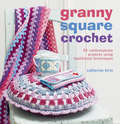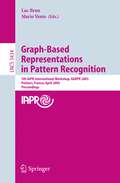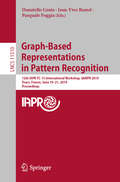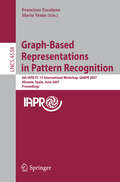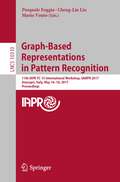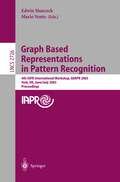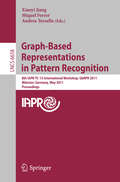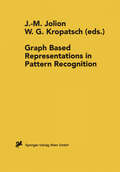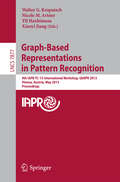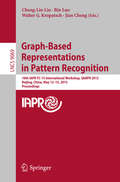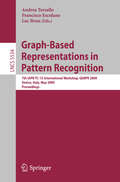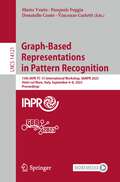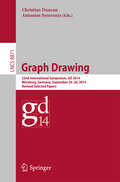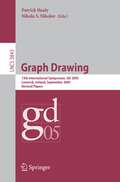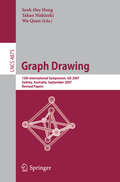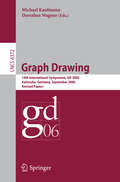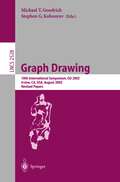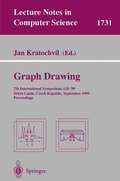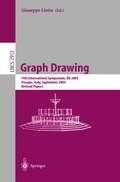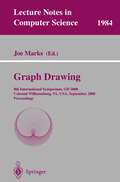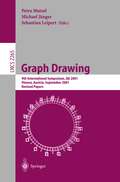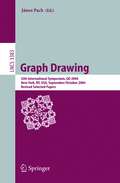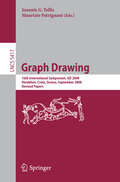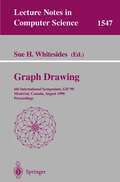- Table View
- List View
Granny Square Crochet: 35 contemporary projects using traditional techniques
by Catherine HirstMake over 35 fabulous projects, from quick and easy scarves to mug cosies. The granny square is the starting point for many people when they first learn to crochet, but as their skills progress, this versatile crochet block is often forgotten. In Granny Square Crochet , crochet teacher Catherine Hirst presents 35 projects which show how this traditional square can be updated and used in many different ways. The first chapter has over a dozen projects for the home, ranging from a blue-and-white mug cosy which can be made in less than an hour, to a stunning bed cover. There are cushions and seat covers to brighten up your living room, plus place mats, drinks coasters and a runner for your table. The second chapter has some great accessories, including gloves, scarves and bags, and even a dog coat to keep your favourite hound warm in winter. The third chapter has a great range of patterns to make as gifts for children and babies, such as crib and pram blankets, bibs, hats and toys. Each project is graded according to the level of skill required, and there is a comprehensive basic techniques chapter explaining all you need to know. Catherine Hirst was taught crochet at a young age by her grandmother and took to it immediately - she quickly learned to knit and embroider as well, and has been hand-making clothing, accessories, and gifts ever since. Her first book, Teeny Tiny Crochet , is also published by CICO Books.
Granny's Kitchen Cupboard: A Lifetime In Over 100 Objects
by John AlexanderAccumulated over many years, 'Granny', the enigmatic collector behind this book, presents a selection of quirky post-war goods, advertising and kitchen items.
Graph-Based Representations in Pattern Recognition: 5th IAPR International Workshop, GbRPR 2005, Poitiers, France, April 11-13, 2005, Proceedings (Lecture Notes in Computer Science #3434)
by Luc Brun Mario VentoMany vision problems have to deal with di?erent entities (regions, lines, line junctions, etc.) and their relationships. These entities together with their re- tionships may be encoded using graphs or hypergraphs. The structural inf- mation encoded by graphs allows computer vision algorithms to address both the features of the di?erent entities and the structural or topological relati- ships between them. Moreover, turning a computer vision problem into a graph problem allows one to access the full arsenal of graph algorithms developed in computer science. The Technical Committee (TC15, http://www.iapr.org/tcs.html) of the IAPR (International Association for Pattern Recognition) has been funded in order to federate and to encourage research work in these ?elds. Among its - tivities, TC15 encourages the organization of special graph sessions at many computer vision conferences and organizes the biennial workshop GbR. While being designed within a speci?c framework, the graph algorithms developed for computer vision and pattern recognition tasks often share constraints and goals with those developed in other research ?elds such as data mining, robotics and discrete geometry. The TC15 community is thus not closed in its research ?elds but on the contrary is open to interchanges with other groups/communities.
Graph-Based Representations in Pattern Recognition: 12th IAPR-TC-15 International Workshop, GbRPR 2019, Tours, France, June 19–21, 2019, Proceedings (Lecture Notes in Computer Science #11510)
by Donatello Conte Jean-Yves Ramel Pasquale FoggiaThis book constitutes the refereed proceedings of the 12th IAPR-TC-15 International Workshop on Graph-Based Representation in Pattern Recognition, GbRPR 2019, held in Tours, France, in June 2019.The 22 full papers included in this volume together with an invited talk were carefully reviewed and selected from 28 submissions. The papers discuss research results and applications at the intersection of pattern recognition, image analysis, and graph theory. They cover topics such as graph edit distance, graph matching, machine learning for graph problems, network and graph embedding, spectral graph problems, and parallel algorithms for graph problems.
Graph-Based Representations in Pattern Recognition: 6th IAPR-TC-15 International Workshop, GbRPR 2007, Alicante, Spain, June 11-13, 2007, Proceedings (Lecture Notes in Computer Science #4538)
by Francisco Escolano Mario VentoThis book constitutes the refereed proceedings of the 6th IAPR-TC-15 International Workshop on Graph-Based Representations in Pattern Recognition, GbRPR 2007, held in Alicante, Spain in June 2007. It covers matching, distances and measures, graph-based segmentation and image processing, graph-based clustering, graph representations, pyramids, combinatorial maps and homologies, as well as graph clustering, embedding and learning.
Graph-Based Representations in Pattern Recognition: 11th IAPR-TC-15 International Workshop, GbRPR 2017, Anacapri, Italy, May 16–18, 2017, Proceedings (Lecture Notes in Computer Science #10310)
by Pasquale Foggia Cheng-Lin Liu Mario VentoThis book constitutes the refereed proceedings of the 11th IAPR-TC-15 International Workshop on Graph-Based Representation in Pattern Recognition, GbRPR 2017, held in Anacapri, Italy, in May 2017. The 25 full papers and 2 abstracts of invited papers presented in this volume were carefully reviewed and selected from 31 submissions. The papers discuss research results and applications in the intersection of pattern recognition, image analysis, graph theory, and also the application of graphs to pattern recognition problems in other fields like computational topology, graphic recognition systems and bioinformatics.
Graph Based Representations in Pattern Recognition: 4th IAPR International Workshop, GbRPR 2003, York, UK, June 30 - July 2, 2003. Proceedings (Lecture Notes in Computer Science #2726)
by Edwin Hancock Mario VentoThe refereed proceedings of the 4th IAPR International Workshop on Graph-Based Representation in Pattern Recognition, GbRPR 2003, held in York, UK in June/July 2003. The 23 revised full papers presented were carefully reviewed and selected for inclusion in the book. The papers are organized in topical sections on data structures and representation, segmentation, graph edit distance, graph matching, matrix methods, and graph clustering.
Graph-Based Representations in Pattern Recognition: 8th IAPR-TC-15 International Workshop, GbRPR 2011, Münster, Germany, May 18-20, 2011, Proceedings (Lecture Notes in Computer Science #6658)
by Xiaoyi Jiang Miquel Ferrer Andrea TorselloThis book constitutes the refereed proceedings of the 8th IAPR-TC-15 International Workshop on Graph-Based Representations in Pattern Recognition, GbRPR 2011, held in Münster, Germany, in May 2011. The 34 revised full papers presented were carefully reviewed and selected from numerous submissions. The papers are organized in topical sections on graph-based representation and characterization, graph matching, classification, and querying, graph-based learning, graph-based segmentation, and applications.
Graph Based Representations in Pattern Recognition (Computing Supplementa #12)
by Jean-Michel Jolion Walter KropatschGraph-based representation of images is becoming a popular tool since it represents in a compact way the structure of a scene to be analyzed and allows for an easy manipulation of sub-parts or of relationships between parts. Therefore, it is widely used to control the different levels from segmentation to interpretation. The 14 papers in this volume are grouped in the following subject areas: hypergraphs, recognition and detection, matching, segmentation, implementation problems, representation.
Graph-Based Representations in Pattern Recognition: 9th IAPR-TC-15 International Workshop, GbRPR 2013, Vienna, Austria, May 15-17, 2013, Proceedings (Lecture Notes in Computer Science #7877)
by Walter Kropatsch Nicole M. Artner Yll Haxhimusa Xiaoyi JiangThis book constitutes the refereed proceedings of the 9th IAPR-TC-15 International Workshop on Graph-Based Representations in Pattern Recognition, GbRPR 2013, held in Vienna, Austria, in May 2013. The 24 papers presented in this volume were carefully reviewed and selected from 27 submissions. They are organized in topical sections named: finding subregions in graphs; graph matching; classification; graph kernels; properties of graphs; topology; graph representations, segmentation and shape; and search in graphs.
Graph-Based Representations in Pattern Recognition: 10th IAPR-TC-15 International Workshop, GbRPR 2015, Beijing, China, May 13-15, 2015. Proceedings (Lecture Notes in Computer Science #9069)
by Cheng-Lin Liu Bin Luo Walter G. Kropatsch Jian ChengThis book constitutes the refereed proceedings of the 10th IAPR-TC-15 International Workshop on Graph-Based Representations in Pattern Recognition, GbRPR 2015, held in Beijing, China, in May 2015. The 36 papers presented in this volume were carefully reviewed and selected from 53 submissions. The accepted papers cover diverse issues of graph-based methods and applications, with 7 in graph representation, 15 in graph matching, 7 in graph clustering and classification, and 7 in graph-based applications.
Graph-Based Representations in Pattern Recognition: 7th IAPR-TC-15 International Workshop, GbRPR 2009, Venice, Italy, May 26-28, 2009. Proceedings (Lecture Notes in Computer Science #5534)
by Andrea Torsello Francisco Escolano Ruiz Luc BrunGraph-Based Representations in Pattern Recognition: 13th IAPR-TC-15 International Workshop, GbRPR 2023, Vietri sul Mare, Italy, September 6–8, 2023, Proceedings (Lecture Notes in Computer Science #14121)
by Mario Vento Pasquale Foggia Donatello Conte Vincenzo CarlettiThis book constitutes the refereed proceedings of the 13th IAPR-TC-15 International Workshop on Graph-Based Representations in Pattern Recognition, GbRPR 2023, which took place in Vietri sul Mare, Italy, in September 2023.The 16 full papers included in this book were carefully reviewed and selected from 18 submissions. They were organized in topical sections on graph kernels and graph algorithms; graph neural networks; and graph-based representations and applications.
Graph Drawing: 22nd International Symposium, GD 2014, Würzburg, Germany, September 24-26, 2014, Revised Selected Papers (Lecture Notes in Computer Science #8871)
by Christian Duncan Antonios SymvonisThis book constitutes the proceedings of the 22nd International Symposium on Graph Drawing, GD 2014, held in Würzburg, Germany, in September 2014. The 41 full papers presented in this volume were carefully reviewed and selected from 72 submissions. The back matter of the book also contains 2 page poster papers presented at the conference. The contributions are organized in topical sections named: planar subgraphs; simultaneous embeddings; applications; contact representations; k-planar graphs; crossing minimization; level drawings; theory; fixed edge directions; drawing under constraints; clustered planarity; and greedy graphs.
Graph Drawing: 13 th International Symposium, GD 2005, Limerick, Ireland, September 12-14, 2005, Revised Papers (Lecture Notes in Computer Science #3843)
by Patrick Healy Nikola S. NikolovThe 13th International Symposium on Graph Drawing (GD 2005) was held in Limerick, Ireland, September 12-14, 2005. One hundred and ?fteen participants from 19 countries attended GD 2005. In response to the call for papers the Program Committee received 101 subm- sions, each detailing original research or a system demonstration. Each submission was reviewed by at least three Program Committee members; each referee’s c- ments were returned to the authors. Following extensive discussions, the comm- tee accepted 38 long papers, 3 short papers and 3 long system demos, each of which were presented during one of the conference’s 12 sessions. Eight posters were also accepted and were on display throughout the conference. Two invited speakers, Kurt Mehlhorn and George Robertson, gave fascinating talks during the conference. Prof. Mehlhorn spoke on the use of minimum cycle bases for reconstructing surfaces, while Dr. Robertson gave a perspective, past and present, on the visualization of hierarchies. As is now traditional, a graph drawing contest was held during the conference. The accompanying report, written by Stephen Kobourov, details this year’s c- test. This year a day-long workshop, organized by Seok-Hee Hong and Dorothea Wagner, was held in conjunction with the conference. A report on the “Workshop on Network Analysis and Visualization,” written by Seok-Hee Hong, is included in the proceedings.
Graph Drawing: 15th International Symposium, GD 2007, Sydney, Australia, September 24-26, 2007, Revised Papers (Lecture Notes in Computer Science #4875)
by Seok-Hee Hong Takao Nishizeki Wu QuanThis comprehensive new Springer publication constitutes the thoroughly refereed post-conference proceedings of the 15th International Symposium on Graph Drawing, GD 2007, held in Sydney, Australia, in September of 2007. The 27 full papers and 9 short papers presented together with 2 invited talks, and a report on the symposium’s graph drawing contest were carefully selected from 74 initial submissions. All of the current hot topics in graph drawing are addressed here.
Graph Drawing: 14th International Symposium, GD 2006, Karlsruhe, Germany, September 18-20, 2006, Revised Papers (Lecture Notes in Computer Science #4372)
by Michael Kaufmann Dorothea WagnerThis book constitutes the thoroughly refereed post-proceedings of the 14th International Symposium on Graph Drawing, GD 2006, held in Karlsruhe, Germany. The 33 revised full papers and 5 revised short papers presented together with 2 invited talks, 1 system demo, 2 poster papers address all current aspects in graph drawing, ranging from foundational and methodological issues to applications for various classes of graphs in a variety of fields.
Graph Drawing: 10th International Symposium, GD 2002, Irvine, CA, USA, August 26-28, 2002, Revised Papers (Lecture Notes in Computer Science #2528)
by Stephen G. Kobourov Michael T. GoodrichGraph Drawing: 7th International Symposium, GD'99, Stirin Castle, Czech Republic, September 15-19, 1999 Proceedings (Lecture Notes in Computer Science #1731)
by Jan KratochvílThe range of issues considered in graph drawing includes algorithms, graph theory, geometry, topology, order theory, graphic languages, perception, app- cations, and practical systems. Much research is motivated by applications to systems for viewing and interacting with graphs. The interaction between th- retical advances and implemented solutions is an important part of the graph drawing eld. The annually organized graph drawing symposium is a forum for researchers, practitioners, developers, and users working on all aspects of graph visualization and representations. The preceding symposia were held in M- treal (GD’98), Rome (GD’97), Berkeley (GD’96), Passau (GD’95), Princeton (GD’94), and Paris (GD’93). The Seventh International Symposium on Graph Drawing GD’99 was or- nized at Sti r n Castle, in the vicinity of Prague, Czech Republic. This baroque castle recently restored as a hotel and conference center provided a secluded place for the participants, who made good use of the working atmosphere of the conference. In total the symposium had 83 registered participants from 16 countries.
Graph Drawing: 11th International Symposium, GD 2003, Perugia, Italy, September 21-24, 2003, Revised Papers (Lecture Notes in Computer Science #2912)
by Guiseppe LiottaThe 11th International Symposium on Graph Drawing (GD 2003) was held on September 21–24, 2003, at the Universit` a degli Studi di Perugia, Perugia, Italy. GD 2003 attracted 93 participants from academic and industrial institutions in 17 countries. In response to the call for papers, the program committee received 88 re- larsubmissionsdescribingoriginalresearchand/orsystemdemonstrations.Each submission was reviewed by at least 4 program committee members and c- ments were returned to the authors. Following extensive e-mail discussions, the program committee accepted 34 long papers (12 pages each in the proceedings) and 11 short papers (6 pages each in the proceedings). Also, 6 posters (2 pages each in the proceedings) were displayed in the conference poster gallery. In addition to the 88 submissions, the program committee also received a submission of special type, one that was not competing with the others for a time slot in the conference program and that collects selected open problems in graph drawing. The aim of this paper, which was refereed with particular care andUNCHANGEDtworoundsofrevisions,istostimulatefutureresearchinthe graph drawing community. The paper presents 42 challenging open problems in di?erentareasofgraphdrawingandcontainsmorethan120references.Although the length of the paper makes it closer to a journal version than to a conference extended abstract, we decided to include it in the conference proceedings so that it could easily reach in a short time the vast majority of the graph drawing community.
Graph Drawing: 8th International Symposium, GD 2000, Colonial Williamsburg, VA, USA, September 20-23, 2000, Proceedings (Lecture Notes in Computer Science #1984)
by Joe MarksThis year’s meeting marked the Eighth International Symposium on Graph D- wing. The organizing and program committees worked hard to make this year’s symposium possible, and we were delighted that so many people came to - lonial Williamsburg, Virginia, for three days of the latest results in the eld of graph drawing. As in previous years, the review process was quite competitive. We accepted 30 out of 53 regular-length submissions, and 5 out of 15 short submissions, for a total acceptance ratio of 35 out of 68, or 51%. This year’s program featured several new developments in the eld. Four di erent approaches for handling very large graphs were presented in a session on force-directed layout. Two sessions were devoted to the latest advances in orthogonal graph drawing. And alongside the usual mix of theory and practice papers we had several contributions based on empirical studies of users and of systems. Our invited talks were given by two speakers who were new to most members of the GD community, but who work in areas that are closely related to graph drawing. Professor Colin Ware of the University of New Hampshire told us how knowledge of human visual perception is useful for the design of e ective data visualizations. And Professor David Jensen of the University of Massachusetts at Amherst talked about the process of knowledge discovery from graphs, a process that involves more than just graph drawing and visualization.
Graph Drawing: 9th International Symposium, GD 2001 Vienna, Austria, September 23-26, 2001, Revised Papers (Lecture Notes in Computer Science #2265)
by Petra Mutzel Michael Jünger Sebastian LeipertGraph Drawing: 12th International Symposium, GD 2004, New York, NY, USA, September 29-October 2, 2004, Revised Selected Papers (Lecture Notes in Computer Science #3383)
by Janos PachGraph Drawing: 16th International Symposium, GD 2008, Heraklion, Crete, Greece, September 21-24, 2008, Revised Papers (Lecture Notes in Computer Science #5417)
by Ioannis G. Tollis Maurizio PatrignaniThe 16th International Symposium on Graph Drawing (GD 2008) was held in Hersonissos, near Heraklion, Crete, Greece, September 21-24, 2008, and was attended by 91 participants from 19 countries. In response to the call for papers the Program Committee received 83 s- missions,eachdescribing originalresearchand/or a systemdemonstration.Each submissionwasreviewedbyatleastthreeProgramCommitteemembersandthe reviewer’s comments were returned to the authors. Following extensive disc- sions, the committee accepted 31 long papers and 8 short papers. In addition, 10 posters were accepted and displayed at the conference site. Each poster was granted a two-page description in the conference proceedings. Two invited speakers, Jesper Tegn´ er from Karolinska Institute (Monday) and Roberto Tamassia from Brown University (Tuesday), gave fascinating talks during the conference. Professor Tegn´ er focused on the challenges and oppor- nities posed by the discovery, analysis, and interpretation of biological networks to information visualization, while Prof. Tamassia showed how graph drawing techniques can be used as an e?ective tool in computer security and pointed to future research directions in this area. Following what is now a tradition, the 15th Annual Graph Drawing Contest was held during the conference, also including a Graph Drawing Challenge to the conference attendees. A report is included in the conference proceedings.
